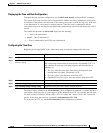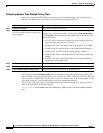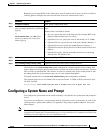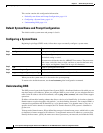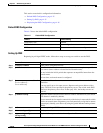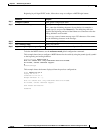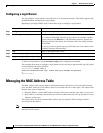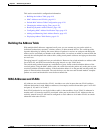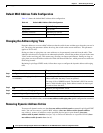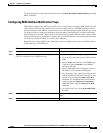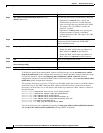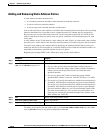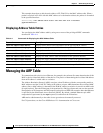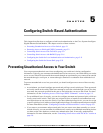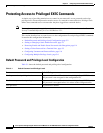
4-19
Cisco Systems Intelligent Gigabit Ethernet Switch Modules for the IBM BladeCenter, Software Configuration Guide
24R9746
Chapter 4 Administering the Switch
Managing the MAC Address Table
This section contains this configuration information:
• Building the Address Table, page 4-19
• MAC Addresses and VLANs, page 4-19
• Default MAC Address Table Configuration, page 4-20
• Changing the Address Aging Time, page 4-20
• Removing Dynamic Address Entries, page 4-20
• Configuring MAC Address Notification Traps, page 4-21
• Adding and Removing Static Address Entries, page 4-23
• Displaying Address Table Entries, page 4-24
Building the Address Table
With multiple MAC addresses supported on all ports, you can connect any port on the switch to
individual workstations, repeaters, switches, routers, or other network devices. The switch provides
dynamic addressing by learning the source address of packets it receives on each port and adding the
address and its associated port number to the address table. As stations are added or removed from the
network, the switch updates the address table, adding new dynamic addresses and aging out those that
are not in use.
The aging interval is configured on a per-switch basis. However, the switch maintains an address table
for each VLAN, and STP can accelerate the aging interval on a per-VLAN basis.
The switch sends packets between any combination of ports, based on the destination address of the
received packet. Using the MAC address table, the switch forwards the packet only to the port or ports
associated with the destination address. If the destination address is on the port that sent the packet, the
packet is filtered and not forwarded. The switch always uses the store-and-forward method: complete
packets are stored and checked for errors before transmission.
MAC Addresses and VLANs
All addresses are associated with a VLAN. An address can exist in more than one VLAN and have
different destinations in each. Multicast addresses, for example, could be forwarded to port 1 in VLAN 1
and ports 9, 10, and 11 in VLAN 5.
Each VLAN maintains its own logical address table. A known address in one VLAN is unknown in
another until it is learned or statically associated with a port in the other VLAN. Addresses that are
statically entered in one VLAN must be configured as static addresses in all other VLANs or remain
unlearned in the other VLANs.



